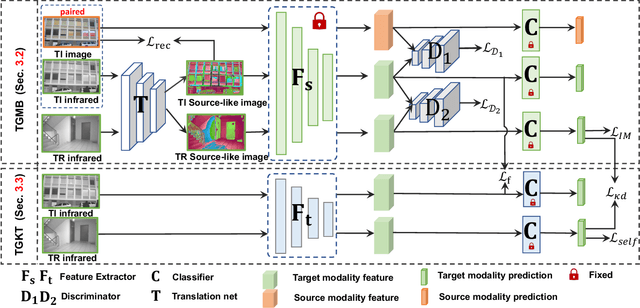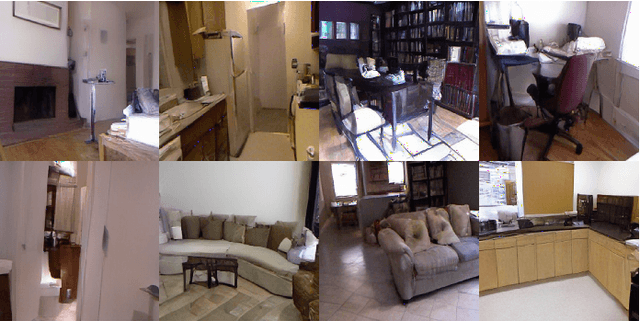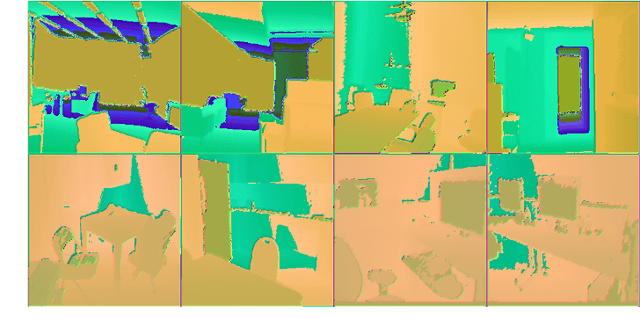Yucheng Chen
MedUnifier: Unifying Vision-and-Language Pre-training on Medical Data with Vision Generation Task using Discrete Visual Representations
Mar 06, 2025



Abstract:Despite significant progress in Vision-Language Pre-training (VLP), current approaches predominantly emphasize feature extraction and cross-modal comprehension, with limited attention to generating or transforming visual content. This gap hinders the model's ability to synthesize coherent and novel visual representations from textual prompts, thereby reducing the effectiveness of multi-modal learning. In this work, we propose MedUnifier, a unified VLP framework tailored for medical data. MedUnifier seamlessly integrates text-grounded image generation capabilities with multi-modal learning strategies, including image-text contrastive alignment, image-text matching and image-grounded text generation. Unlike traditional methods that reply on continuous visual representations, our approach employs visual vector quantization, which not only facilitates a more cohesive learning strategy for cross-modal understanding but also enhances multi-modal generation quality by effectively leveraging discrete representations. Our framework's effectiveness is evidenced by the experiments on established benchmarks, including uni-modal tasks (supervised fine-tuning), cross-modal tasks (image-text retrieval and zero-shot image classification), and multi-modal tasks (medical report generation, image synthesis), where it achieves state-of-the-art performance across various tasks. MedUnifier also offers a highly adaptable tool for a wide range of language and vision tasks in healthcare, marking advancement toward the development of a generalizable AI model for medical applications.
CLIP the Divergence: Language-guided Unsupervised Domain Adaptation
Jul 01, 2024Abstract:Unsupervised domain adaption (UDA) has emerged as a popular solution to tackle the divergence between the labeled source and unlabeled target domains. Recently, some research efforts have been made to leverage large vision-language models, such as CLIP, and then fine-tune or learn prompts from them for addressing the challenging UDA task. In this work, we shift the gear to a new direction by directly leveraging CLIP to measure the domain divergence and propose a novel language-guided approach for UDA, dubbed as CLIP-Div. Our key idea is to harness CLIP to 1) measure the domain divergence via the acquired domain-agnostic distribution and 2) calibrate the target pseudo labels with language guidance, to effectively reduce the domain gap and improve the UDA model's generalization capability. Specifically, our major technical contribution lies in the proposed two novel language-guided domain divergence measurement losses: absolute divergence and relative divergence. These loss terms furnish precise guidelines for aligning the distributions of the source and target domains with the domain-agnostic distribution derived from CLIP. Additionally, we propose a language-guided pseudo-labeling strategy for calibrating the target pseudo labels. Buttressed by it, we show that a further implementation for self-training can enhance the UDA model's generalization capability on the target domain. CLIP-Div surpasses state-of-the-art CNN-based methods by a substantial margin, achieving a performance boost of +10.3% on Office-Home, +1.5% on Office-31, +0.2% on VisDA-2017, and +24.3% on DomainNet, respectively.
eMoE-Tracker: Environmental MoE-based Transformer for Robust Event-guided Object Tracking
Jun 28, 2024Abstract:The unique complementarity of frame-based and event cameras for high frame rate object tracking has recently inspired some research attempts to develop multi-modal fusion approaches. However, these methods directly fuse both modalities and thus ignore the environmental attributes, e.g., motion blur, illumination variance, occlusion, scale variation, etc. Meanwhile, no interaction between search and template features makes distinguishing target objects and backgrounds difficult. As a result, performance degradation is induced especially in challenging conditions. This paper proposes a novel and effective Transformer-based event-guided tracking framework, called eMoE-Tracker, which achieves new SOTA performance under various conditions. Our key idea is to disentangle the environment into several learnable attributes to dynamically learn the attribute-specific features for better interaction and discriminability between the target information and background. To achieve the goal, we first propose an environmental Mix-of-Experts (eMoE) module that is built upon the environmental Attributes Disentanglement to learn attribute-specific features and environmental Attributes Gating to assemble the attribute-specific features by the learnable attribute scores dynamically. The eMoE module is a subtle router that fine-tunes the transformer backbone more efficiently. We then introduce a contrastive relation modeling (CRM) module to improve interaction and discriminability between the target information and background. Extensive experiments on diverse event-based benchmark datasets showcase the superior performance of our eMoE-Tracker compared to the prior arts.
Source-Free Cross-Modal Knowledge Transfer by Unleashing the Potential of Task-Irrelevant Data
Jan 10, 2024



Abstract:Source-free cross-modal knowledge transfer is a crucial yet challenging task, which aims to transfer knowledge from one source modality (e.g., RGB) to the target modality (e.g., depth or infrared) with no access to the task-relevant (TR) source data due to memory and privacy concerns. A recent attempt leverages the paired task-irrelevant (TI) data and directly matches the features from them to eliminate the modality gap. However, it ignores a pivotal clue that the paired TI data could be utilized to effectively estimate the source data distribution and better facilitate knowledge transfer to the target modality. To this end, we propose a novel yet concise framework to unlock the potential of paired TI data for enhancing source-free cross-modal knowledge transfer. Our work is buttressed by two key technical components. Firstly, to better estimate the source data distribution, we introduce a Task-irrelevant data-Guided Modality Bridging (TGMB) module. It translates the target modality data (e.g., infrared) into the source-like RGB images based on paired TI data and the guidance of the available source model to alleviate two key gaps: 1) inter-modality gap between the paired TI data; 2) intra-modality gap between TI and TR target data. We then propose a Task-irrelevant data-Guided Knowledge Transfer (TGKT) module that transfers knowledge from the source model to the target model by leveraging the paired TI data. Notably, due to the unavailability of labels for the TR target data and its less reliable prediction from the source model, our TGKT model incorporates a self-supervised pseudo-labeling approach to enable the target model to learn from its predictions. Extensive experiments show that our method achieves state-of-the-art performance on three datasets (RGB-to-depth and RGB-to-infrared).
Towards Dynamic and Small Objects Refinement for Unsupervised Domain Adaptative Nighttime Semantic Segmentation
Oct 07, 2023Abstract:Nighttime semantic segmentation is essential for various applications, e.g., autonomous driving, which often faces challenges due to poor illumination and the lack of well-annotated datasets. Unsupervised domain adaptation (UDA) has shown potential for addressing the challenges and achieved remarkable results for nighttime semantic segmentation. However, existing methods still face limitations in 1) their reliance on style transfer or relighting models, which struggle to generalize to complex nighttime environments, and 2) their ignorance of dynamic and small objects like vehicles and traffic signs, which are difficult to be directly learned from other domains. This paper proposes a novel UDA method that refines both label and feature levels for dynamic and small objects for nighttime semantic segmentation. First, we propose a dynamic and small object refinement module to complement the knowledge of dynamic and small objects from the source domain to target nighttime domain. These dynamic and small objects are normally context-inconsistent in under-exposed conditions. Then, we design a feature prototype alignment module to reduce the domain gap by deploying contrastive learning between features and prototypes of the same class from different domains, while re-weighting the categories of dynamic and small objects. Extensive experiments on four benchmark datasets demonstrate that our method outperforms prior arts by a large margin for nighttime segmentation. Project page: https://rorisis.github.io/DSRNSS/.
Heuristic Satisficing Inferential Decision Making in Human and Robot Active Perception
Sep 14, 2023



Abstract:Inferential decision-making algorithms typically assume that an underlying probabilistic model of decision alternatives and outcomes may be learned a priori or online. Furthermore, when applied to robots in real-world settings they often perform unsatisfactorily or fail to accomplish the necessary tasks because this assumption is violated and/or they experience unanticipated external pressures and constraints. Cognitive studies presented in this and other papers show that humans cope with complex and unknown settings by modulating between near-optimal and satisficing solutions, including heuristics, by leveraging information value of available environmental cues that are possibly redundant. Using the benchmark inferential decision problem known as ``treasure hunt", this paper develops a general approach for investigating and modeling active perception solutions under pressure. By simulating treasure hunt problems in virtual worlds, our approach learns generalizable strategies from high performers that, when applied to robots, allow them to modulate between optimal and heuristic solutions on the basis of external pressures and probabilistic models, if and when available. The result is a suite of active perception algorithms for camera-equipped robots that outperform treasure-hunt solutions obtained via cell decomposition, information roadmap, and information potential algorithms, in both high-fidelity numerical simulations and physical experiments. The effectiveness of the new active perception strategies is demonstrated under a broad range of unanticipated conditions that cause existing algorithms to fail to complete the search for treasures, such as unmodelled time constraints, resource constraints, and adverse weather (fog).
Deep Learning for Omnidirectional Vision: A Survey and New Perspectives
May 24, 2022



Abstract:Omnidirectional image (ODI) data is captured with a 360x180 field-of-view, which is much wider than the pinhole cameras and contains richer spatial information than the conventional planar images. Accordingly, omnidirectional vision has attracted booming attention due to its more advantageous performance in numerous applications, such as autonomous driving and virtual reality. In recent years, the availability of customer-level 360 cameras has made omnidirectional vision more popular, and the advance of deep learning (DL) has significantly sparked its research and applications. This paper presents a systematic and comprehensive review and analysis of the recent progress in DL methods for omnidirectional vision. Our work covers four main contents: (i) An introduction to the principle of omnidirectional imaging, the convolution methods on the ODI, and datasets to highlight the differences and difficulties compared with the 2D planar image data; (ii) A structural and hierarchical taxonomy of the DL methods for omnidirectional vision; (iii) A summarization of the latest novel learning strategies and applications; (iv) An insightful discussion of the challenges and open problems by highlighting the potential research directions to trigger more research in the community.
Monocular Human Pose Estimation: A Survey of Deep Learning-based Methods
Jun 02, 2020



Abstract:Vision-based monocular human pose estimation, as one of the most fundamental and challenging problems in computer vision, aims to obtain posture of the human body from input images or video sequences. The recent developments of deep learning techniques have been brought significant progress and remarkable breakthroughs in the field of human pose estimation. This survey extensively reviews the recent deep learning-based 2D and 3D human pose estimation methods published since 2014. This paper summarizes the challenges, main frameworks, benchmark datasets, evaluation metrics, performance comparison, and discusses some promising future research directions.
* This version corresponds to the pre-print of the paper accepted for Computer Vision and Image Understanding (CVIU)
Self-supervised Modal and View Invariant Feature Learning
May 28, 2020



Abstract:Most of the existing self-supervised feature learning methods for 3D data either learn 3D features from point cloud data or from multi-view images. By exploring the inherent multi-modality attributes of 3D objects, in this paper, we propose to jointly learn modal-invariant and view-invariant features from different modalities including image, point cloud, and mesh with heterogeneous networks for 3D data. In order to learn modal- and view-invariant features, we propose two types of constraints: cross-modal invariance constraint and cross-view invariant constraint. Cross-modal invariance constraint forces the network to maximum the agreement of features from different modalities for same objects, while the cross-view invariance constraint forces the network to maximum agreement of features from different views of images for same objects. The quality of learned features has been tested on different downstream tasks with three modalities of data including point cloud, multi-view images, and mesh. Furthermore, the invariance cross different modalities and views are evaluated with the cross-modal retrieval task. Extensive evaluation results demonstrate that the learned features are robust and have strong generalizability across different tasks.
Self-supervised Feature Learning by Cross-modality and Cross-view Correspondences
Apr 13, 2020



Abstract:The success of supervised learning requires large-scale ground truth labels which are very expensive, time-consuming, or may need special skills to annotate. To address this issue, many self- or un-supervised methods are developed. Unlike most existing self-supervised methods to learn only 2D image features or only 3D point cloud features, this paper presents a novel and effective self-supervised learning approach to jointly learn both 2D image features and 3D point cloud features by exploiting cross-modality and cross-view correspondences without using any human annotated labels. Specifically, 2D image features of rendered images from different views are extracted by a 2D convolutional neural network, and 3D point cloud features are extracted by a graph convolution neural network. Two types of features are fed into a two-layer fully connected neural network to estimate the cross-modality correspondence. The three networks are jointly trained (i.e. cross-modality) by verifying whether two sampled data of different modalities belong to the same object, meanwhile, the 2D convolutional neural network is additionally optimized through minimizing intra-object distance while maximizing inter-object distance of rendered images in different views (i.e. cross-view). The effectiveness of the learned 2D and 3D features is evaluated by transferring them on five different tasks including multi-view 2D shape recognition, 3D shape recognition, multi-view 2D shape retrieval, 3D shape retrieval, and 3D part-segmentation. Extensive evaluations on all the five different tasks across different datasets demonstrate strong generalization and effectiveness of the learned 2D and 3D features by the proposed self-supervised method.
 Add to Chrome
Add to Chrome Add to Firefox
Add to Firefox Add to Edge
Add to Edge